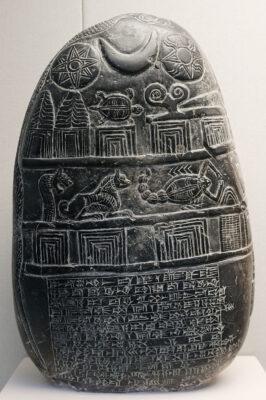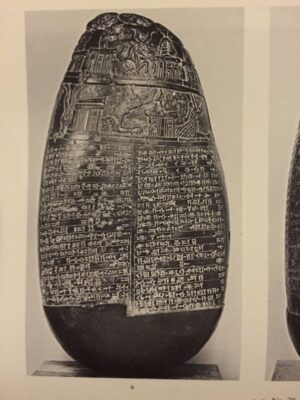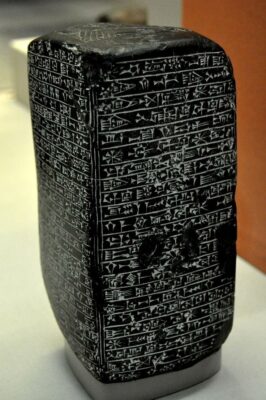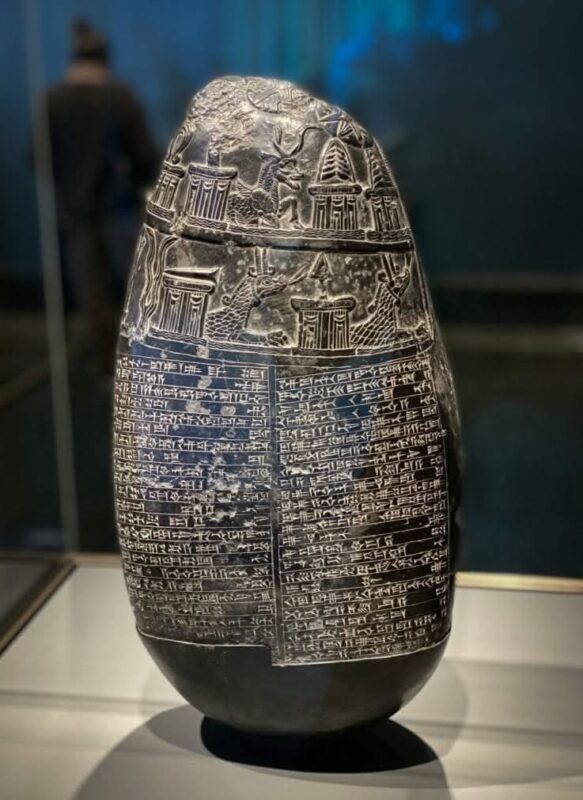The kudurru stele, originating in ancient Mesopotamia during the Kassite period (16th–12th century BCE), holds significant historical and cultural importance. These boundary stones were used to document land grants made by kings to individuals or temples, blending legal documentation with religious symbolism. Follow archeology.dulichvn.net to discover many hidden mysteries that have yet to be discovered.

Origins of the Kudurru Stele
Historical Background
The Kassite period in ancient Mesopotamia, spanning roughly from the 16th to the 12th century BCE, was a time of significant legal and administrative development. During this era, the kudurru stele emerged as a crucial tool for documenting land ownership and ensuring protection for both the land and its holder. These steles were not merely physical markers but acted as a combination of legal documents and religious artifacts, reflecting the intertwined nature of law and spirituality in Mesopotamian society.
Materials and Craftsmanship
Kudurru steles were meticulously crafted using durable materials such as limestone or clay, chosen for their longevity and ease of inscription. The surfaces of these steles were carefully smoothed and prepared to receive intricate cuneiform inscriptions. These inscriptions were typically detailed and comprehensive, outlining the boundaries of the granted land, the specific terms of the agreement, and the rights and obligations associated with the property. Each stele required precision and skill, with a focus on clarity and permanence, ensuring that the legal record could endure through time.
Symbolism and Design
The design of kudurru steles was deeply symbolic, incorporating various elements that conveyed both legal authority and divine protection. Common motifs included representations of Mesopotamian deities, such as Anu, Enlil, and Marduk, who symbolized cosmic order and the legitimacy of the land grant.
Alongside these deities, protective symbols—often in the form of geometric patterns or divine emblems—served to safeguard the agreement from any disputes or challenges. These artistic features highlighted the sacred aspect of the steles, transforming them from mere boundary markers into sacred instruments imbued with divine authority. The combination of legal text and religious imagery ensured that the kudurru stele transcended its physical form, becoming a powerful emblem of both earthly and heavenly protection.

Legal and Religious Functionality
Legal Documentation
Kudurru steles served as indispensable legal instruments in ancient Mesopotamia, playing a vital role in documenting land ownership and ensuring the enforcement of agreements. These steles were carefully inscribed with cuneiform text that provided detailed records of land grants, including the boundaries, terms, and conditions of the transaction. By serving as tangible proof of ownership, kudurru steles protected both the grantor and the grantee, offering a reliable means to resolve disputes and establish legal certainty. Their durability and inscription format ensured that the agreements remained unaltered over time, safeguarding the rights of landowners against future challenges or claims.
Religious Significance
Beyond their legal functionality, kudurru steles held profound religious significance in Mesopotamian society. Stored within sacred spaces such as temples, these steles symbolized the intertwining of earthly justice and divine authority. The presence of these artifacts in temples reinforced the belief that land grants were not merely secular transactions but were endorsed and protected by the gods. The divine imagery and symbols inscribed on the steles further emphasized this relationship, with deities acting as guardians of the agreements, ensuring their sanctity and adherence.
Protection and Authority
The inclusion of curses on kudurru steles was a widely practiced custom, serving as a deterrent against tampering or disputes. These curses were solemn invocations of divine power designed to maintain the integrity of the land agreements.
They called upon the gods to impose severe consequences on anyone who attempted to alter or challenge the established terms. By embedding such divine warnings within the inscriptions, kudurru steles effectively wielded both legal and supernatural authority, ensuring the stability and security of land transactions for generations. This fusion of legal documentation and spiritual authority highlights the comprehensive approach taken to protect land rights in ancient Mesopotamian society.

See more: King Ramses VI: The Final Pharaoh of Egypt’s Twentieth Dynasty
Preservation and Legacy
Historical Insights
Surviving kudurru steles offer a wealth of information about ancient Mesopotamian society, law, religion, and art. These remarkable artifacts provide a unique window into the complexities of a civilization that deeply intertwined legal practices with religious beliefs.
Through the detailed inscriptions and symbolic designs, scholars gain a deeper understanding of how land ownership was managed, how disputes were settled, and how divine authority was invoked to ensure the stability of agreements. The steles serve not only as historical documents but also as cultural touchstones, shedding light on the values, norms, and artistic expressions that defined Mesopotamian civilization.
Museum Collections
Kudurru steles are preserved in museums around the world, offering a crucial resource for both academic research and public appreciation of ancient Near Eastern history. These museums provide a platform for scholars to explore the intricate details of the steles, while also engaging the public in the rich heritage of Mesopotamian culture.
By displaying these artifacts, museums contribute to a broader understanding of how ancient societies navigated legal, religious, and artistic complexities. The preservation and exhibition of kudurru steles ensure that future generations can continue to study and appreciate the historical significance of these fascinating objects.

Conclusion
The kudurru stele serves as a powerful testament to the sophisticated legal systems and deeply rooted spiritual beliefs of ancient Mesopotamia. These artifacts seamlessly merge the domains of law and religion, offering a unique historical insight into a civilization where legal practices were intertwined with divine authority and symbolic meaning.
Through its intricate cuneiform inscriptions, vivid symbolism, and inclusion of both legal and religious elements, the kudurru stele represents a remarkable fusion of secular governance and sacred tradition. It stands as a lasting emblem of how ancient Mesopotamians perceived and structured their social, legal, and spiritual worlds, preserving a rich legacy that continues to inform our understanding of their culture.


CÁC TIN KHÁC
Mary Walton: The Forgotten Inventor Who Helped Clean Up America’s Cities
Tomb of Queen Nefertari in the Valley of the Queens, Egypt
Discover the Hypostyle Hall of the Temple of Hathor at Dendera
Venus de Losange: Unveiling the Mystery of a 20,000-Year-Old Paleolithic Icon